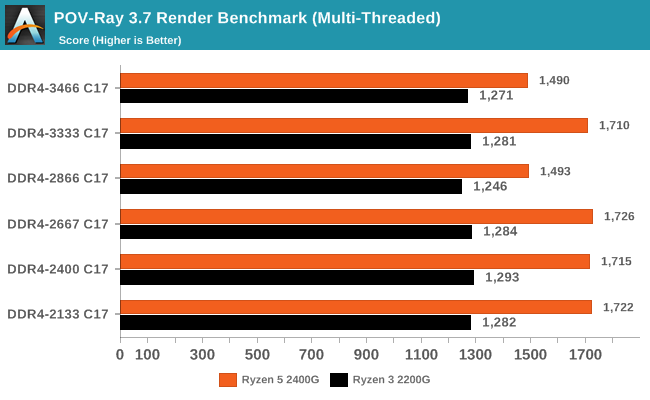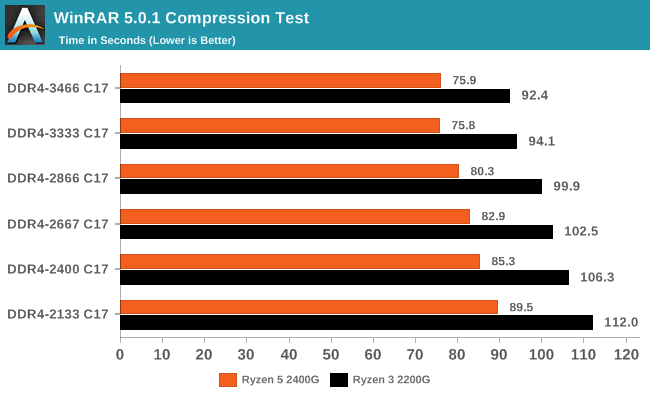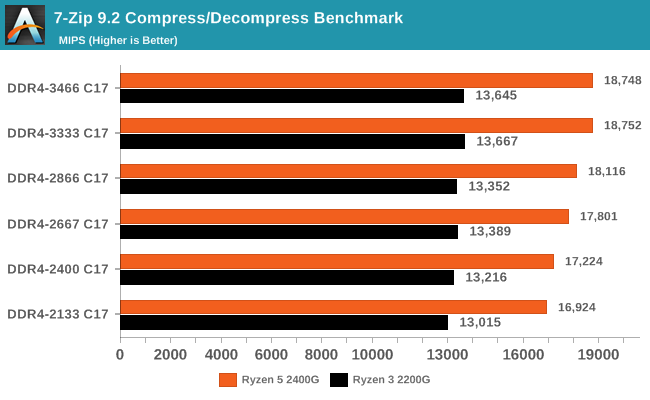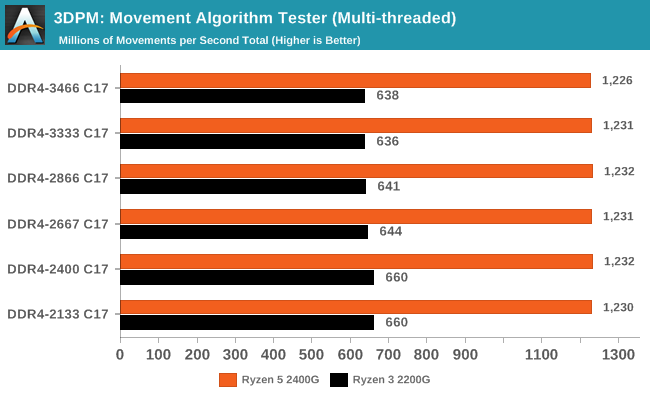Zen and Vega DDR4 Memory Scaling on AMD's APUs
by Gavin Bonshor on June 28, 2018 9:00 AM EST- Posted in
- CPUs
- Memory
- G.Skill
- AMD
- DDR4
- DRAM
- APU
- Ryzen
- Raven Ridge
- Scaling
- Ryzen 3 2200G
- Ryzen 5 2400G
CPU Performance
Rendering - Blender 2.78: link
For a render that has been around for what seems like ages, Blender is still a highly popular tool. We managed to wrap up a standard workload into the February 5 nightly build of Blender and measure the time it takes to render the first frame of the scene. Being one of the bigger open source tools out there, it means both AMD and Intel work actively to help improve the codebase, for better or for worse on their own/each other's microarchitecture.

While memory speed does influence our final rendering duration consistently by shaving seconds off, the jump from DDR4-2133 to DDR4-3333 equates to a 2% reduction overall on the Ryzen 3 2200G, although the last step from 3333 to 3466 is actually a regression. The Ryzen 5 2400G experienced a reduction of just under 4%.
Rendering – POV-Ray 3.7: link
The Persistence of Vision Ray Tracer, or POV-Ray, is a freeware package for as the name suggests, ray tracing. It is a pure renderer, rather than modeling software, but the latest beta version contains a handy benchmark for stressing all processing threads on a platform. We have been using this test in motherboard reviews to test memory stability at various CPU speeds to good effect – if it passes the test, the IMC in the CPU is stable for a given CPU speed. As a CPU test, it runs for approximately 1-2 minutes on high-end platforms.

Our results in POV-Ray 3.7 were a little hit and miss and showed irregularities at different memory clock speeds, perhaps due to the additional power required by the memory controller at higher frequencies taking away from available CPU power. This means POV-Ray isn’t really influenced more by the memory speeds themselves, although it is certainly more determined from more CPU cores and higher frequencies as the difference between the 2200G and 2400G show.
WinRAR 5.4: link
Our WinRAR test from 2013 is updated to the latest version of WinRAR at the start of 2014. We compress a set of 2867 files across 320 folders totaling 1.52 GB in size – 95% of these files are small typical website files, and the rest (90% of the size) are small 30-second 720p videos.

As the memory frequency was increased, the compression time was consistently lower going up a memory strap. With WinRAR being one of our most DRAM-affected CPU tests, we have seen this before with other CPU generations. The 2200G saw a 21% increase in throughput, while the 2400G had a +18% gain. However it is worth noting that the DDR4-3466 time was slightly slower than that of the DDR4-3333 time again.
7-Zip 9.2: link
As an open source compression tool, 7-Zip is a popular tool for making sets of files easier to handle and transfer. The software offers up its own benchmark, to which we report the result.

The 7-Zip results are interesting as with both Ryzen based APUs at the DDR4-3333 setting saw the biggest benefit in compression and decompressing. Again, the top strap in our testing was not the most performant. Overall gains were +11% for the 2400G, and +5% for the 2200G, in line with thread counts.
Point Calculations – 3D Movement Algorithm Test: link
3DPM is a self-penned benchmark, taking basic 3D movement algorithms used in Brownian Motion simulations and testing them for speed. High floating point performance, MHz, and IPC win in the single thread version, whereas the multithread version has to handle the threads and loves more cores. For a brief explanation of the platform agnostic coding behind this benchmark, see my forum post here.

With our 3DPM Brownian Motion simulator benchmark, memory frequency made little difference in increasing performance, although as our results show, the slower the memory, the better performance we experienced on the Ryzen 3 2200G. The Ryzen 2400G experienced a similar range of inconsistent and inconsequential results showing little to no improvement as the memory strap was increased.
Neuron Simulation - DigiCortex v1.20: link
The newest benchmark in our suite is DigiCortex, a simulation of biologically plausible neural network circuits, and simulates activity of neurons and synapses. DigiCortex relies heavily on a mix of DRAM speed and computational throughput, indicating that systems which apply memory profiles properly should benefit and those that play fast and loose with overclocking settings might get some extra speed up. Results are taken during the steady state period in a 32k neuron simulation and represented as a function of the ability to simulate in real time (1.000x equals real-time).

DigiCortex experienced a very subsequent increase throughout the tested memory straps on both the Ryzen APUs, with a nice jump in performance of 22% on the 2200G and on the 2400G.










74 Comments
View All Comments
Meat Hex - Thursday, June 28, 2018 - link
I would not read into these graphs and tests too much as they are only showing you the % gained from higher speed memory and not the actual FPS. You're still going to have a higher FPS on the 2400G vs the 2200G.PeachNCream - Thursday, June 28, 2018 - link
The 2200G is a reasonable CPU and the price is good for the performance you get back. If you do upgrade to a dedicated graphics card later (unlikely given the HTPC role you're aiming for due to heat, power, noise, and space concerns) the dGPU benchmarks show most of the games measured demonstrate the 2200G is relatively close in performance to the 2400G so there's that as well.sing_electric - Thursday, June 28, 2018 - link
Especially for an HTPC, "good enough" performance is often EXACTLY what you want, especially when you're considering chips on the same architecture/process, since the 2200G will make less heat, making the entire system run cooler, which, in turn, can mean a quieter system.Lolimaster - Friday, June 29, 2018 - link
It's all about the extra thread that will minimize stuttering from 4c/4t cpu, and will handle better a dgpu higher than a 1060.GreenReaper - Friday, June 29, 2018 - link
To be honest it might make the most sense to buy the APU, then the dGPU later, then a later-model CPU using 7nm architecture to replace the APU.drzzz - Thursday, June 28, 2018 - link
After reading the article I was expecting a conclusion to talk heavily about DDR-3333 memory and how it performed the best overall and clearly point out that speeds over that seemed to fall off and maybe some insightful thoughts on why that was seen. Given the spikes at 2933 and 3333 compared to 2400 it would seem to indicate there is some steady state synergy with the IF, memory and the caching mechanics that only manifest at specific bounds in the frequency increase. Again expected more about these two points in a conclusion vice the 2133 to 3466 differences that were talked about. The performance at 2933 and 3333 makes me curious if there is some logical hard design choice AMD made that would make memory selection easier for us once we identify it and if the same factors play into all the Zen based CPU's. I find it interesting that the xx33 speeds seem to be the strong points. So I am curious what would 2533 and 3733 look like. I know 3733 is not a realistic option. If the xx33 speeds are the best performing across the spectrum I would seriously love to know why and if same is true for Zen base CPU's.peevee - Tuesday, July 3, 2018 - link
"Given the spikes at 2933 and 3333"No spikes, the steps are different in size.
And of course the simply misleading slowing of latencies on slower frequencies by setting CL etc to the same value.
zodiacfml - Thursday, June 28, 2018 - link
Do a review of the GT 1030 with DDR4.PeachNCream - Thursday, June 28, 2018 - link
Do you mean the GT 1030 that uses DDR4 on the card as opposed to the GDDR5 model? If that's the case, I'd like to second that. The performance difference between the two memory types would be worth analyzing. As the GDDR5 model is a bit ahead of AMD's APUs, I'd imagine the DDR4 model would cost enough performance to hand the performance advantage back to a 2400g, but it'd be useful to see that play out in Anandtech's benchmarks.TheWereCat - Thursday, June 28, 2018 - link
Gamers Nexus released their review yesterday.Apparently the GT1030 DDR4 is so starved for memory bandwidth that at best it performs "only" 50% worse than the GDDR5 version and at worst it falls 2x short.
That makes it worse than a 2200G paired with a single channel 2400MHz DDR4.